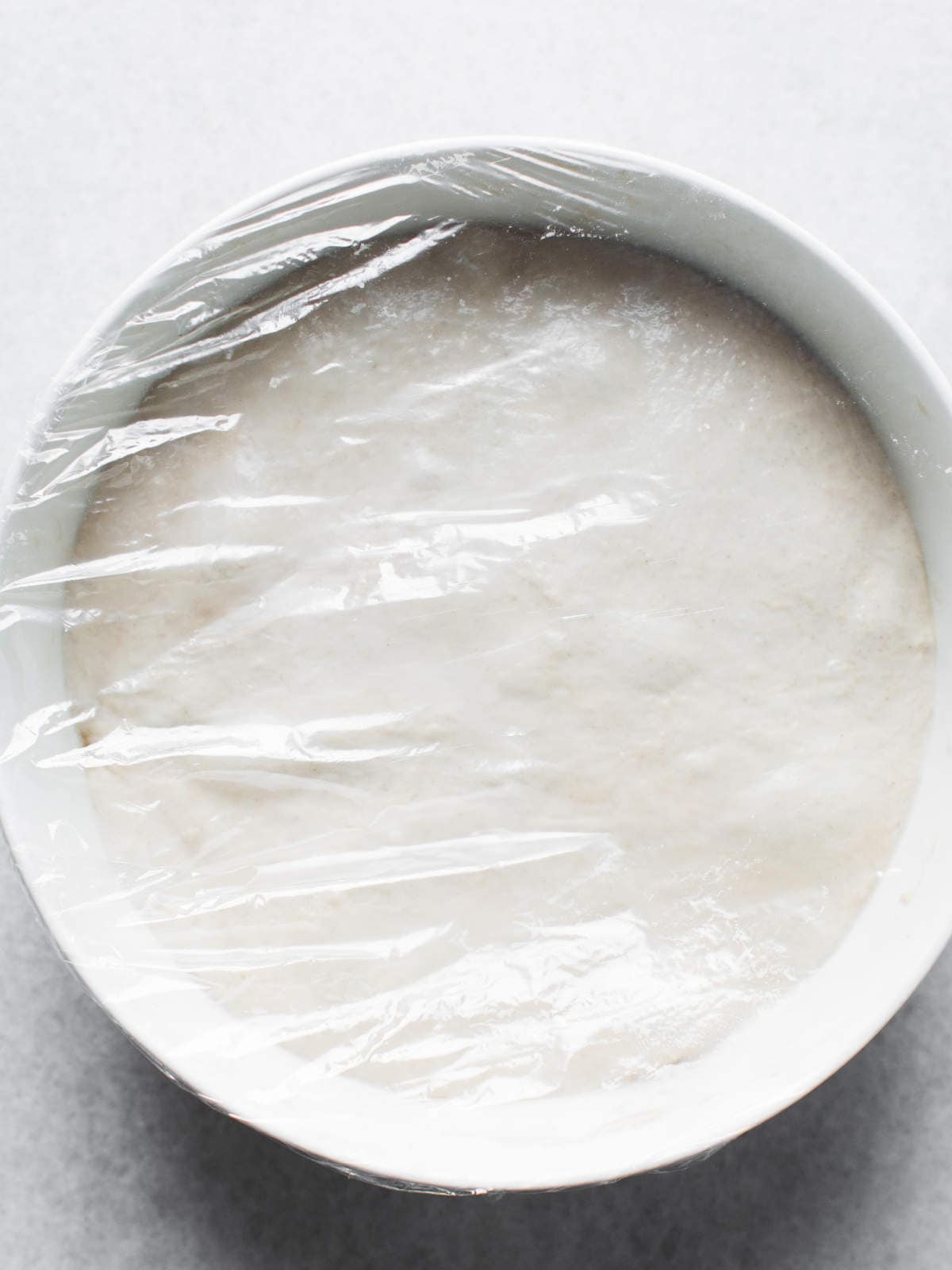Have you ever wondered what is a levain when reading a bread recipe? A levain, also called a preferment, is essentially a scaled-up version of your existing sourdough starter.
By mixing your starter with extra flour and water, you create a larger amount of active culture perfect for bigger batches of bread.
Levain = Sourdough Secret Ingredient
It's the secret ingredient is behind the tangy flavor and distinctive rise of sourdough bread? Often referred to as a sourdough starter build, a levain plays a crucial role in sourdough baking.
When creating a levain, you take a small portion of your starter and "feed" it with fresh flour and water. This kickstarts a period of renewed fermentation specifically for your upcoming loaf.
It's then incorporated into the main dough, where it continues to ferment and leaven the bread, resulting in the characteristic sourdough magic.
Jump to:
- Levain = Sourdough Secret Ingredient
- Why This Recipe Preferment Recipe Works
- Breads That Use A Levain
- Ingredients To Make Your Own
- How To Make A Levain
- Substitutions and Variations
- Tips for Success
- The Results
- Related Recipes
- Equipment
- Storage and Reheating
- Frequently Asked Questions
- More Delicious Bread Ideas
- Simple Levain Recipe
Why This Recipe Preferment Recipe Works
This preferment technique offers another benefit: influencing the final flavor. Adding fresh flour and water dilutes the tanginess of your mature starter, resulting in a milder sourdough flavor in your bread.
This can be desirable for recipes where a subtle sourdough note complements other ingredients, rather than overpowering them.
- Simple Ingredients: Utilizes a small portion of your existing sourdough starter with readily available flour and water.
- Easy to Follow: Requires minimal steps and hands-on time for a rewarding result.
- Modifies Flavor and Texture: The levain allows you to modulate the flavor and tang in the final bread outcome.
- Flexible for Use: This simple technique can be adapted to various sourdough bread recipes.
Breads That Use A Levain
Levain, the hero ingredient behind naturally leavened breads, plays a starring role in a variety of loaves, both savory and sweet. Here's a look at some popular breads that frequently rely on this preferment for their distinctive flavor and texture:
- Sourdough Bread: The undisputed champion of levain-based breads, sourdough boasts a tangy flavor and a beautiful open crumb thanks to its wild yeast and bacteria culture.
- Chocolate Babka: This swirled sweet bread, often filled with chocolate or cinnamon, can be made even more flavorful with the addition of a levain preferment. It contributes a hint of tang that complements the sweetness of the filling perfectly.
- Bâtard: This rustic French loaf features a long, slender shape and a crispy crust. Levain contributes to its signature tang and chewy interior.
- Brioche buns: While not all brioche recipes use levain, some bakers prefer to incorporate a small amount of levain to add a subtle tang and enhance the flavor profile of these rich and buttery buns.
- Panettone: This rich Italian Christmas bread traditionally relies on a biga (a type of preferment) to develop its complex flavor and light, airy texture. While some variations might use commercial yeast for faster results, true Panettone benefits from the slow fermentation process of a levain.
- Pain au Levain: This French term literally translates to "bread with leaven," solidifying levain's importance in this traditional loaf. Pain au Levain offers a delightful balance of tang and sweetness.
Ingredients To Make Your Own
This recipe relies on just three key ingredients:
- Active Sourdough Starter: A portion of your established sourdough starter harbors the active wild yeast and bacteria for fermentation.
- Bread Flour: Provides the structure and foundation for the levain. High-gluten flour can also be used.
- Water: Activates the yeast and allows for dough formation.
Full ingredient amounts and preparation instructions are in the printable recipe card at the bottom of this post.

How To Make A Levain
This guide dives into the wonderful world of levain, exploring its role in sourdough baking, the unique qualities it imparts on bread, and a simple recipe to create your own levain at home.
So, get ready to elevate your sourdough game with the help of your trusty levain!
Mix Sourdough Starter With Flour and Water
- In a medium bowl, combine the sourdough starter, bread flour, and water.
- Using a spoon or your hands, mix until a shaggy dough forms. Mix until the flour is all gone.

Allow To Ferment 4 to 6 Hours
- Cover the bowl loosely with plastic wrap or a damp cloth.
- Let it rise at room temperature (around 70°F/21°C) for 4-6 hours.
- During this time, it will become bubbly and roughly double in size. It may also develop a slightly domed shape.

Ready To Bake With!
- It's ready to use when it reaches its peak volume and shows good activity.

Substitutions and Variations
Here are a few delicious variations when making this preferment recipe.
- Bread Flour vs. All-Purpose Flour: While bread flour is ideal for its higher gluten content, all-purpose flour can be used in a pinch.
- Hydration Level: This recipe creates a hydration level of 100% (equal parts flour and water by weight). You can adjust the hydration level slightly depending on your desired final bread dough consistency.
Tips for Success
Here are a few tips for making this preferment recipe:
- Use a mature and healthy sourdough starter for optimal results.
- Ensure all ingredients are at room temperature for best activation of the yeast.
- The rising time can vary depending on room temperature.
- If your kitchen is cool, it might take closer to 6 hours for the levain to reach its peak.
The Results
Once your levain is ready, you can incorporate it into your favorite sourdough bread recipe. The levain will contribute to the unique flavor and texture that defines sourdough bread.
Whether you're making sweet Panettone or a rustic Pain Au Levain, this levain process will allow you to modulate the level of sourdough tang, crumb texture, and flavor of the final bread.

Related Recipes
- How To Make A Sourdough Starter
- What Is A Pâte Fermentée?
- Sourdough Discard Naan
- Jewish Shabbat Challah
Equipment
Equipment can have a big impact on how a recipe turns out. Below are some of my favorite pieces of equipment that I use when making this dish.
Storage and Reheating
- Leftover levain can be stored in the refrigerator in an airtight container for up to 2 weeks.
- Before using refrigerated levain, allow it to come to room temperature and perform a rounds of feeding (mixing with fresh flour and water) to revive it.
Frequently Asked Questions
1. Perhaps an inactive starter: Ensure your sourdough starter is mature and healthy before using it to create the levain. 2. Temperature: The room temperature might be too cool. Try placing the levain in a warm spot to encourage fermentation.
More Delicious Bread Ideas
Simple Levain Recipe
Ingredients
- 50 grams Mature sourdough starter 3½ tbsp
- 50 grams Bread flour ¾ cup
- 35 grams Water ¼ cup + 1 tbsp
Instructions
- In a medium bowl, combine the sourdough starter, bread flour, and water.50 grams Mature sourdough starter, 50 grams Bread flour, 35 grams Water
- Using a spoon or your hands, mix until a shaggy dough forms.
- Cover the bowl loosely with plastic wrap or a damp cloth.
- Let the levain rise at room temperature (around 70°F/21°C) for 4-6 hours.
- During this time, the levain will become bubbly and roughly double in size. It may also develop a slightly domed shape.
- Your levain is ready to use when it reaches its peak volume and shows good activity.
Notes
- Use a mature and healthy sourdough starter for optimal results.
- Ensure all ingredients are at room temperature for best activation of the yeast.
- The rising time can vary depending on room temperature.
- If your kitchen is cool, it might take closer to 6 hours for the levain to reach its peak.










Leave a Reply